Efficient Gable End Framing <!—-><!—-> <!—->
Combining residential and commercial techniques, and using a couple of innovative tools, makes for more efficient gable end framing.<!—-> <!—->
<!—-> View Image <!—->
Here are a few simple tricks I thought of while framing this gable end. As I relate these techniques, I’ll also explain some basic tricks of the trade that I don’t always see utilized in the field. Feel free to add any tips you think could also be useful. <!—-><!—->
It’s far less complicated to layout any windows first, but after that I like to layout the rest of the studs with a Stud Line layout line. It’s similar to a chalk line, but only leaves 1-1/2″ of chalk every 16″. The tool is also available in 24″ increments, or you can special order whatever size you’d like – every 12″ for concrete forms or every 19.2″ for TGI’s for example. This tool will save me the time of crawling on the floor with my tape measure and marking each increment with my pencil.<!—-> <!—->
You might be wondering how I can guarantee the Stud Line will be pulled at the proper tension, thus rendering an accurate layout. Whenever I use the Stud Line, I always mark the layout of the last stud within 24′ with my tape measure. The Stud Line is 25′ long. Once I match up the last layout mark on the Stud Line with the last layout line I made with my tape, I know that I have the proper tension. Since I’m working alone, and since there is also nothing to hook onto inside the gable end (for the Stud Line or my tape measure), I must also mark the layout of the first stud and drive an 8d nail there to hook onto.<!—-> <!—->
<!—-> <!—->
I use John Carrol’s technique (For Pros by Pros: Working Alone) of snapping the chalk line without a helper, by holding the end of it in place with my foot. Once the increments are marked, I work my way back with my speed square and pencil, making one line only for each stud. This allows me to make my layout consistent – both inside and outside the wall – despite any twists there may be in the lumber. The second line I see some builders draw for the other side of the stud serves no purpose, and is a waste of time.<!—-> <!—->
<!—-> <!—->
Instead of using a level, or the even slower plumb bob, I prefer to use a laser plumb bob to transfer my layout to the gable rafters. Many lasers on the market don’t offer enough accuracy, but this one from Pacific Laser Systems offers accuracy within 100′. This is the laser professionals use in commercial construction when framing with metal studs. When I do layout work, I also like to use the round pencils you get from lumber yards (as opposed to the typical rectangular carpenter’s pencil), because it allows you to easily carve a precise point.
<!—->View Image <!—->
<!—-> View Image <!—->
I like to work with a full length piece of lumber, so that I can easily mark and cut studs for both sides of the gable at one time. I want the studs notched to fit around the gable rafter for face-nailing, but I also want them to be of consistent length for appearance sake. I mark the length of the notch with my speed square, which allows me to use the same tool to mark the bevel cut at the bottom of the notch, as well as mark the rip. I prefer using a genuine <!—-><!—-> <!—->Swanson Speed Square<!—-> <!—-> because it makes marking rips so easy. <!—-><!—->
<!—-> View Image <!—->
First I plunge into the edge of the stud to cut the bevel, and then I finish the notch by making the rip. I then pull off the bottom of my notch to mark the stud for length. My saw is set to a 1-1/2″ depth, which is of course the same thickness of the 2x and the 2x rafter I’m notching for.<!—-><!—->
<!—-> View Image <!—->
Something I see a lot of guys do is pull their tape measure, make a mark, and then retract their tape measure and make another mark with their speed square. However, it is possible to skip a step by pulling your tape measure, then placing your speed square under your tape measure, then retracting your tape and making your full mark the first time.
View Image <!—-><!—->
<!—-> View Image <!—->
Once the pieces are cut, I shoot three 16d face-nails into them at the top, and three 16d toenails at the bottom. To prevent possible splitting, I stagger the ones at the bottom so that no nail directly opposes another – two on one side, one on the other.
View Image <!—-><!—->
<!—-> View Image <!—->
After measuring the first two studs, there’s no need to measure any more. I use the old gable end framing technique called “the common length difference.” Whatever difference there is between the first and second studs is what I will add to each additional stud. From there the process simply repeats itself.<!—-><!—->
I’d post the finished product, but that’s about when my digital camera broke – Oh well.<!—-><!—->
–T
Edited 8/24/2007 2:48 am by JourneymanCarpenterT
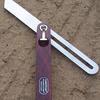


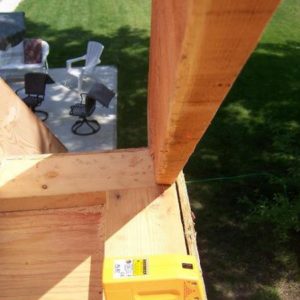

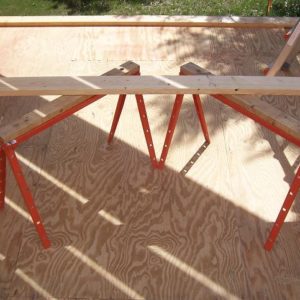
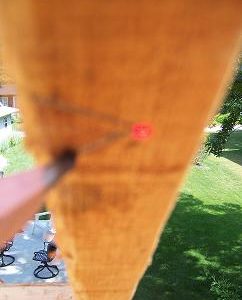

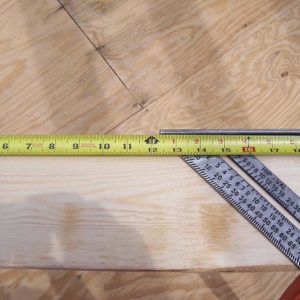



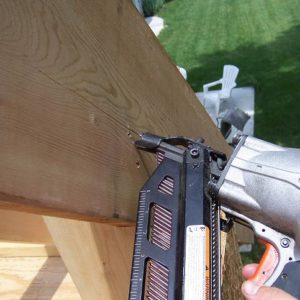





















Replies
Alright, I have to go somewhere for a while this evening, so nobody get all mean while I'm gone.
-T
Where did you get your stud line?
I'm assuming that it's just a normal chalk line with some type of non-porous sleeve that covers 14-1/2" out of every 16". Is this right?
My google search was fruitless.
Jon Blakemore
RappahannockINC.com Fredericksburg, VA
journey...
thanks for the nice series....
how come you don't frame your gable ends on the deck and stand them up ?Mike Smith Rhode Island : Design / Build / Repair / Restore
I didn't have any wall jacks at the time, but the more I think about that question, the more I wish I did. If I ever get around to working for myself again, I'll make sure I have them handy. I don't know if they're available at stores in your area or not, but around here you have to special order that kind of thing.-T
http://studline.com/-T
Nice series dude.
Couple things.....
1. Why not do all that framing while the gable is still laying on the deck? Much easier to take care of all that work at 'ground level' then up there in the air. Get all your framing done, sheath it, build your cornice returns, and trim that sucker out. If you're working alone..... all the more reason to invest in a set of wall jacks, or better yet... a Lull.
2. You cut everything but the first stud with your Construction Master.... why not cut the first stud that way as well and leave the laser in the truck? The distance from the "short point" of your rafter seat cut to the stud line is your "run". The "pitch" is just the roof pitch. Then hit "Rise" and you have your first stud length. Next punch in your common difference (in length) and hit (+) then (=) and you have your second stud length. Hit (=) again for number three. Lather, rinse, repeat.
Same method can be used for find those window kings too.
Word of caution though about using the CM for stud lengths..... make sure you're using rafter stock with little or no crown for your gable ends or your studs will be either too short or out of plumb towards center span.
Which all bring me to another reason why I don't stick frame gables in place... only on the deck and rarely by math alone. I set my rafters to a temp ridge block laying on the deck. Then layout, cut and install the longest stud in the gable. Then pull the entire rest of my layout off this stud and mark it on the rafter. Now I put my tape away for good. I just butt studs to the bottom plate, line 'em up with my marks on the rafter and mark them for cutting.
One other thing... but it's probably just personal preference..... I've never found anything faster than my tape for layout. I've tried the "Studline" as well as layout sticks, but I always go back to my good old tape. Maybe that's just me though.
Not trying to criticize your well written and nicely detailed thread. Just offering a few different perspectives because that's the best way we can all learn. I see a new technique, pick out the parts that work for me, and leave the rest. Hope you'll do the same.
I'll have to get those wall jacks. Those are some killer tips you have for the Construction Master! A dozen thanks for that one, that thing never ceases to amaze me. I don't know if that tip was in that one article in Fine Homebuilding or not, but if it was, I sure didn't remember it. The Stud Line seems to be a close call as to whether it's faster, primarily because of the fact that it's essential to pull your tape out first to establish the proper tension. If they ever solve the tension problem, or if they ever make one say 50' long that still maintains accuracy, I think a lot more guys would use one.-T